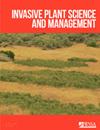Using the nuclear LEAFY gene to reconstruct phylogenetic relationships among invasive knotweed (Reynoutria, Polygonaceae) populations
IF 1.2
4区 生物学
Q3 PLANT SCIENCES
引用次数: 2
Abstract
Abstract Knotweed species in the genus Reynoutria are native to eastern Asia but have become noxious weeds in Europe and North America. In the United States, invasive populations of Japanese knotweed (Reynoutria japonica Houtt.), giant knotweed [Reynoutria sachalinensis (F. Schmidt) Nakai], and their interspecific hybrid known as Bohemian knotweed (R. × bohemica Chrtek & Chrtková) continue to expand their ranges. Although these plants are among the most invasive terrestrial species, there are relatively few molecular tools for identifying the parental species, the F1 hybrid, or subsequent hybrids or introgressed individuals. We studied Reynoutria populations in Wisconsin, a state where all three taxa grow, to determine whether molecular data would be useful for distinguishing species and identifying hybrids. We obtained DNA sequence data from the plastid matK gene and the nuclear LEAFY gene and compared these to previously published sequences. Data from the uniparentally inherited matK region included haplotypes attributable to R. japonica and R. sachalinensis. Nuclear data indicated that R. sachalinensis plants are most similar to native plants in Japan, with two Wisconsin accessions exhibiting a monomorphic genotype for the LEAFY gene. Three Wisconsin accessions of R. japonica were each characterized by having three distinct kinds of LEAFY sequence. Most plants in our study were found to possess two or three phylogenetically distinct copies of the LEAFY gene, with the copies being most closely related to R. japonica and R. sachalinensis, respectively, and these were inferred to be interspecific hybrids. Altogether, five kinds of interspecific hybrids were identified, reflecting various combinations of LEAFY sequence types from the parental species. The widespread existence of hybrid plants in Wisconsin, many of which are morphologically identifiable as R. japonica, indicates a cryptic genetic diversity that should be examined more broadly in North America using molecular tools.利用叶核基因重建入侵结缕草(Reynoutria,蓼科)种群的系统发育关系
虎杖属植物原产于东亚,但在欧洲和北美已成为有毒杂草。在美国,入侵种群日本结叶草(Reynoutria japonica Houtt.),巨型结叶草[Reynoutria sachalinensis (F. Schmidt) Nakai],以及它们的种间杂交品种波西米亚结叶草(R. x bohemica Chrtek & chrtkov)继续扩大其范围。尽管这些植物是最具入侵性的陆生物种,但用于鉴定亲本种、F1杂交种或后续杂交种或渐渗个体的分子工具相对较少。我们研究了威斯康辛州的Reynoutria种群,这三个分类群都生长在这个州,以确定分子数据是否对区分物种和识别杂交物种有用。我们获得了质体matK基因和细胞核LEAFY基因的DNA序列数据,并将其与先前发表的序列进行了比较。来自单系遗传的matK区域的数据包括可归属于粳稻和沙沙林稻的单倍型。核数据表明,sachalinensis植物与日本本土植物最相似,威斯康星州的两份材料显示出单一的绿叶基因型。3份威斯康辛粳稻材料均具有3种不同的叶片序列。在我们的研究中,大多数植物都具有2个或3个不同的系统发育拷贝,这些拷贝分别与粳稻和萨沙林稻的亲缘关系最密切,推断它们是种间杂交。共鉴定出5种种间杂交种,反映了亲本种叶片序列类型的不同组合。在威斯康辛州广泛存在的杂交植物,其中许多在形态上可识别为粳稻,表明了一种隐藏的遗传多样性,应该在北美使用分子工具进行更广泛的研究。
本文章由计算机程序翻译,如有差异,请以英文原文为准。
求助全文
约1分钟内获得全文
求助全文
来源期刊

Invasive Plant Science and Management
PLANT SCIENCES-
CiteScore
2.20
自引率
9.10%
发文量
24
审稿时长
6-12 weeks
期刊介绍:
Invasive Plant Science and Management (IPSM) is an online peer-reviewed journal focusing on fundamental and applied research on invasive plant biology, ecology, management, and restoration of invaded non-crop areas, and on other aspects relevant to invasive species, including educational activities and policy issues. Topics include the biology and ecology of invasive plants in rangeland, prairie, pasture, wildland, forestry, riparian, wetland, aquatic, recreational, rights-of-ways, and other non-crop (parks, preserves, natural areas) settings; genetics of invasive plants; social, ecological, and economic impacts of invasive plants and their management; design, efficacy, and integration of control tools; land restoration and rehabilitation; effects of management on soil, air, water, and wildlife; education, extension, and outreach methods and resources; technology and product reports; mapping and remote sensing, inventory and monitoring; technology transfer tools; case study reports; and regulatory issues.
 求助内容:
求助内容: 应助结果提醒方式:
应助结果提醒方式:


